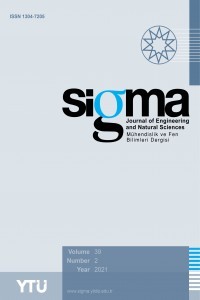DETERMINATION OF OPTIMUM CUTTING PARAMETERS ON FREE FORM SURFACES IN TERMS OF FORM ERRORS AND MACHINING TIMES
DETERMINATION OF OPTIMUM CUTTING PARAMETERS ON FREE FORM SURFACES IN TERMS OF FORM ERRORS AND MACHINING TIMES
Machining of Al7075 ANOVA, form error, Taguchi Method, 3D scanning.,
___
- ⦁ Bouzakis, K. D., Aichouh, P. and Efstathiou, K., (2003) “Determination of the chip geometry, cutting force and roughness in free form surfaces finishing milling, with ball end tools. International Journal of machine tools and manufacture, 43(5), 499-514
- ⦁ de Souza, A. F., Machado, A., Beckert, S. F. and Diniz, A. E., (2014) “Evaluating the roughness according to the tool path strategy when milling free form surfaces for mold application”, Procedia CIRP, 14, 188-193.
- ⦁ Özkan, M. T., Ulas, H. B. and Bilgin, M., (2014) “Experimental design and artificial neural network model for turning the 50CRV4 (sae 6150) alloy using coated carbide/cermet cutting tools”, Materiali in Tehnologije, 48(2), 227-236.
- ⦁ Wojciechowski, S., Maruda, R. W., Barrans, S., Nieslony, P. and Krolczyk, G. M., (2017) “Optimisation of machining parameters during ball end milling of hardened steel with various surface inclinations”, Measurement, 111, 18-28.
- ⦁ Ghani, J. A., Choudhury, I. A. and Hassan, H. H., (2004) “Application of Taguchi method in the optimization of end milling parameters”, Journal of materials processing technology, 145(1), 84-92.
- ⦁ Zhang, J. Z., Chen, J. C. and Kirby, E. D., (2007) “Surface roughness optimization in an end-milling operation using the Taguchi design method”, Journal of materials processing technology, 184(1), 233-239.
- ⦁ Bagci, E. and Yüncüoğlu, E. U., (2017) “The effects of milling strategies on forces, material removal rate, tool deflection, and surface errors for rough machining of complex surfaces”, Strojniški vestnik-Journal of Mechanical Engineering, 63(11), 643-656.
- ⦁ De Lacalle, L. L., Lamikiz, A., Sanchez, J. A., & Salgado, M. A. (2007). Toolpath selection based on the minimum deflection cutting forces in the programming of complex surfaces milling. International Journal of Machine Tools and Manufacture, 47(2), 388-400.
- ⦁ Wang, S. J., To, S., & Cheung, C. F. (2013). An investigation into material-induced surface roughness in ultra-precision milling. The International Journal of Advanced Manufacturing Technology, 68(1-4), 607-616. 9
- ⦁ Wojciechowski, S., & Mrozek, K. (2017). Mechanical and technological aspects of micro ball end milling with various tool inclinations. International Journal of Mechanical Sciences, 134, 424-435. 10
- ⦁ Karabulut, Ş. (2015). Optimization of surface roughness and cutting force during AA7039/Al2O3 metal matrix composites milling using neural networks and Taguchi method. Measurement, 66, 139-149.
- ⦁ Gok, A., Gologlu, C. and Demirci, H. I., (2013) “Cutting parameter and tool path style effects on cutting force and tool deflection in machining of convex and concave inclined surfaces”, The International Journal of Advanced Manufacturing Technology, 69(5-8), 1063-1078.
- ⦁ Yaka, H., Demir, H. and GÖK, A., (2017) “Optimization of the cutting parameters affecting the surface roughness on free form surfaces”, Sigma Journal of Engineering and Natural Sciences, 35(2), 323-331.
- ⦁ Bagci, E. and Yüncüoğlu, E. U., (2017) “The Effects of Milling Strategies on Forces, Material Removal Rate, Tool Deflection, and Surface Errors for Rough Machining of Complex Surfaces”. Strojniški vestnik-Journal of Mechanical Engineering, 63(11), 643-656.
- ⦁ Günay, M. and Yücel, E., (2013) “Application of Taguchi method for determining optimum surface roughness in turning of high-alloy white cast iron”, Measurement, 46(2), 913-919.
- ⦁ Kim, G. M., Kim, B. H. and Chu, C. N., (2003) “Estimation of cutter deflection and form error in ball-end milling processes”, International Journal of Machine Tools and Manufacture, 43(9), 917-924.
- ⦁ Ozdemir, B., Guler, M. S., Bahçe, E. and Aktaş, S., (2016) “Serbest şekilli yüzeylerin frezelenmesinde işleme parametrelerinin form hatası üzerine etkilerinin araştırılması”, Ordu Univ. J. Sci. Tech., 6(2), 300-315.
- ⦁ Erdim, H., Lazoğlu, I., Ozturk, B., (2006) “Feedrate scheduling strategies for free-form surfaces”, International journal of machine tools & manufacture, 46 (7) 747-757.
- ISSN: 1304-7191
- Başlangıç: 1983
- Yayıncı: Yıldız Teknik Üniversitesi
Zeynel Abidin POLAT, Mehmet ALKAN
AN EMPIRICAL APPROACH FOR PROPELLER TIP VORTEX CAVITATION NOISE
Savaş SEZEN, Ali DOĞRUL, Şakir BAL
ANALYTICAL AND NUMERICAL STUDY OF MICROPOLAR FLUID FLOW IN A POROUS PLATE DUE TO LINEAR STRETCHING
Nozar AKBARI, Mosayeb GHOLINIA, Saber GHOLINIA, Soheil DABBAGHIAN, Hossein JAVADI, Davood Domairry GANJI
Harun YAKA, Halil DEMİR, Arif GÖK, Harun AKKUŞ
INVESTIGATION OF WEAR BEHAVIORS OF PROSTHETIC MATERIALS ON BALL-DISC EXPERIMENT
Harun AKKUŞ, Tahsin KAMIŞ, Hayrettin DÜZCÜKOĞLU
EARTQUAKE BEHAVIOUR OF THICK PLATES RESTING ON ELASTIC FOUNDATION WITH FIRST ORDER FINITE ELEMENT
Yakup Emre ÇORUHLU, Bayram UZUN
SYSTEMATICAL REVIEW ON THE NUMERICAL SIMULATIONS OF LASER POWDER BED ADDITIVE MANUFACTURING
Melih Cemal KUŞHAN, Özgür POYRAZ, Yağız UZUNONAT, Sezan ORAK
Ali İhsan ÇELİK, Mehmet Metin KÖSE, Tahir AKGÜL, Ahmet Celal ALPAY
